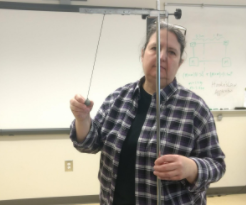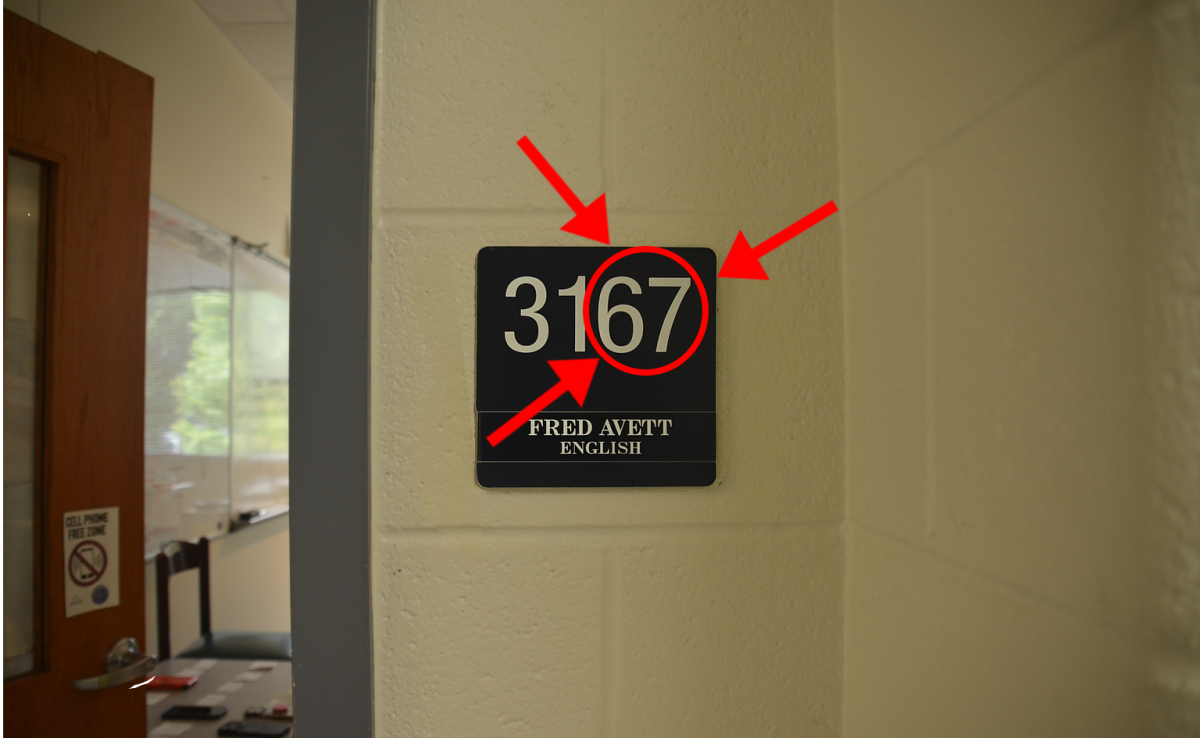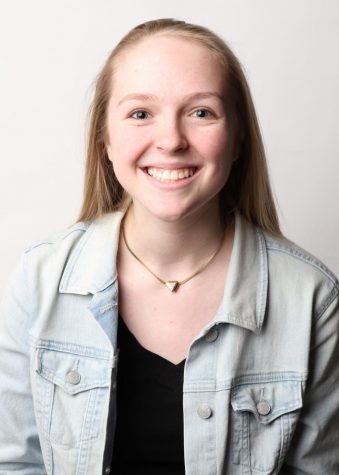Although popular high school movies have made teachers out to be dull, uncreative, and even cruel to students, Chamblee Charter High School’s teachers are bringing a fresh perspective to education. New technology and approaches to teaching challenging content have allowed students of all skill levels to find success.
For anatomy and physiology teacher Leila Warren, this means using her interactive notebook, a workbook that students can write in throughout the year.
“It’s [the interactive notebook] the best teaching strategy I’ve ever used. It’s organized, it’s got science researched based learning style of having teacher input on the right and student output on the left,” said Warren. “I think it allows for a variety of responses from students because they get to choose a lot of time how they show me that they understand their information that’s been taught to them. I have all my stuff in one spot.”
Many of her students agree that the interactive notebook is helpful to their learning.
“I think it’s beneficial because everything is in one spot. There’s no ‘Oh, I lost that sheet of paper,’” said junior Hannah Cain. “It’s such a big thing you have to have for a class, [so] no one loses the interactive notebook.”
Warren also has extension projects, such as wearing a swim cap with the different parts of the brain labeled.
“The notebook is one aspect of anatomy, but again, we do projects for getting the information stuck in their [the student’s] head again in a different way. We do labs, obviously, a lot. I teach them about the body organs and then we dissect them. I think almost every body system has a project with it,” said Warren.
Senior Sidney Luna- Celis described one project anatomy students worked on for the integumentary system.
“We did a tissue box project, and we were trying to apply what we learned about the skin onto a tissue box, and then we gave it out to other teachers so they could have it in their classrooms,” said Luna-Celis.
Luna-Celis sees Warren’s involved teaching style as a reflection of her dedicated and hardworking personality.
“She’s a really good teacher. She’s really involved. She’s always in a good mood … She’s obviously really passionate about teaching,” said Luna-Celis.
Other teachers, such as Advanced Placement (AP) Language and Composition teacher James Demer, rely heavily on class discussions.
“AP Lang[uage and Composition] is an AP class, and in college, when you have an English class, you talk and that’s the only thing you do,” said Demer.
However, he recognizes that not all students can engage during the discussions.
“As a teacher, it’s harder to determine what students are learning if you don’t know what they’re thinking. The students who talk a lot, it’s easy to tell where they’re at. But the others, you need other things like quizzes,” said Demer.
Junior Christine Delon agrees that Demer’s relaxed discussions have both advantages and disadvantages.
“He’s super chill. He tries really really hard [during discussions], but sometimes his teaching style doesn’t really fit my learning style, but I appreciate his effort,” said Delon.
In a similar vein to Demer’s relaxed class atmosphere, math teacher Howard Davenport finds that a casual class lends itself to success in understanding difficult concepts.
“One of the reasons why I try to take a more casual approach to it [teaching math] is because students generally have been under taught math for their whole careers,” said Davenport. “So, the introduction of the subject causes tension and stress, so my philosophy is that if I’m able to, as much as I can, take the stress and the pressure out of it, then it can help the students overcome the obstacles that are caused by just being stressed and actually focus on what’s in front of them.”
He finds that teaching is a careful balance between accommodating both faster and slower learners.
“Oftentimes, upper level kids end up having to do more self-paced learning, but it works well to help people that are struggling a little bit to get them caught back up,” said Davenport.
Ninth and tenth grade literature teacher Holly Isserstedt agrees that she must be flexible in her teaching to accommodate all of her student’s learning methods.
“I do a lot of differentiated instruction for students to have choice,” said Isserstedt.
Differentiation means that each student is able to take advantage of various resources to learn the content in a way that matches their own skill level and pace.
“If they’re [students] struggling with some of the reading, I’ll put some audio or like with my ninth grade students, if we do Shakespeare and they’re struggling with that, I’ll do the No Fear [Shakespeare] copies in class so that they can go back and forth between the original and the translated text,” said Isserstedt.
Physics teacher Marie Cabrices believes in differentiation through online learning and facilitation of resources.
“My philosophy about teaching physics, especially with AP, is that I’m giving you guys the tools that you need to do well on the AP exam. The things that you pick up and use are really up to the students,” said Cabrices. “So, I’m really here more to facilitate your learning, to help you in ways that I can and provide you resources, but really, the learning process needs to fall on you, the student.”
She utilizes online resources such as Webassign, Edmodo, and PhET Interactive Simulations for students to check their comprehension of topics after it is first introduced through a demonstration or inquiry lab. In fact, Cabrices is getting a degree in Instructional Technology to develop her style of education through facilitation.
“I think what’s going to happen, is that there’s going to be a push towards individual learning through technology,” said Cabries. “Teachers’ jobs will become more about facilitating and less about about standing up in front of the students.”
In terms of actually choosing which content to teach, it depends on which type of class the teachers are teaching.
“The curriculum is more specifically defined for tenth grade than it is for ninth, so I have less flexibility with regard to what I teach for tenth grade. Both classes have a writing focus, but ninth grade, obviously, is more foundational skills,” said Isserstedt.
She utilizes the suggested reading list from the DeKalb County curriculum plan, but for AP teachers such as Demer, it is even looser in guidance.
“There’s no AP curriculum requirements. There are suggestions, and a lot of the shorter pieces that we’ve read, like ‘Letter from Birmingham Jail’ for example is a classic AP text, because it has all of the arguments in it, it has all the nonfiction techniques,” said Demer.
He has several books that he feels especially comfortable teaching, such as Maus by Art Spiegelman and The Things They Carried by Tim O’Brien.
“Because we don’t really read that many books, I try to chose stuff that has a wide range of devices employed in them, for examples, and books that are both complex yet all of the reading levels can handle,” said Demer. “The Things They Carried is not a difficult [book]. There’s not words you don’t know, but it’s a complex enough book that if you’re a really good reader, you can get a lot out of it. But if you’re not a really good reader, you can also get a lot out of it.”
Delon has found that Demer’s book assignments are well-selected.
“I like the books that we read. They’re things I wouldn’t really be exposed to, like The Things They Carried is pretty depressing and its about, not exactly my type of thing, but I actually really like it,” said Delon.
Similar to how Demer utilizes class discussions and books he has taught before, Warren uses methods she is comfortable with, including lecturing.
“I do traditional lecturing. Students do Cornell notes, so I give them the notes in the notebook, and they highlight vocabulary one color and important information another color and headings are the third color, and then they go back and they use Bloom’s Level of Questioning to make study questions,” said Warren.
Warren’s students, such as Luna-Celis, find the lectures helpful to their understanding of the content.
“She makes it [lectures] interesting by telling us facts and keeping us awake,” said Luna-Celis, who especially enjoys hearing the anecdotes and stories that Warren will intersperse in her teaching.
But in a broader perspective, all teachers are teaching skills besides specific facts.
“A lot of it [teaching] is whatever is happening right now that’s relevant today. I try to bring in things that are current, really contemporary issues that relate to what I talk about. I try to make those connections as much as I can,” said Isserstedt.








